Ever spent hours comparing boat trailers online, only to end up more confused than when you started?
I’ve been there, frustrated with vague product descriptions and tired of brands that oversell and underdeliver. Over the past 12 years, I’ve worked directly with industrial suppliers and field-tested trailers with construction, mining, and logistics crews.
We know what holds up under pressure and what cracks when you need it most.
So, if you’re here to find a trailer that won’t waste your budget or your time, you’re in the right place.
In this article, I’ll break down 8 different types of boat trailers, how they differ, and who each type is really built for. No fluff, just real-world value.
By the end, you’ll have a clear tool to decide which trailer type offers the best value, performance, and fit for your operations, whether you’re in construction, energy, or agri-transport.
Let’s dive in!
Quick Comparison Chart
Choosing the right boat trailer isn’t just about what fits, it’s about what works for your environment, your crew, and your boat type. Here’s a quick side-by-side comparison of the main differences between the 8 most common boat trailer types to help guide your decision.
| Trailer Type | Launch Suitability | Boat Type Compatibility | Ease of Loading/Unloading | Terrain/Access Needs | Customization Potential |
| Bunk Trailers | Deep ramps only | V-hull, small to mid boats | Moderate | Needs smooth, deep ramp access | Low |
| Roller Trailers | Shallow to deep ramps | Multiple hull types | High | Flexible—works on most ramps | Moderate |
| Float-On Trailers | Deep ramps only | Large and heavy boats | High | Requires good ramp infrastructure | Moderate to High |
| Keel Rollers + Side Bunks | Mixed depth ramps | Medium to large V-hull boats | High | Great for varied environments | Moderate |
| Pontoon Trailers | Deep to moderate ramps | Dual/tri-tube pontoons | Moderate | Wide turns, smooth access needed | Low to Moderate |
| Catamaran Trailers | Deep ramps, ports | Dual-hull/catamaran boats | Moderate | Needs wide road + stable ramp | High |
| Custom/Industrial Trailers | Any launch setup (custom) | Oversized, commercial vessels | Varies (by design) | Built for rugged, industrial use | Very High |
| Tilt Trailers | Shallow or no ramp | Small to mid utility/work boats | High | Great for rough/remote terrain | Low to Moderate |
This table gives you a bird’s-eye view of where each trailer type fits best. Use it to narrow down your options based on your operational environment, boat type, and work conditions.
1. Bunk Trailers
Bunk trailers are the reliable workhorses of the boat-hauling world. They use long, carpeted wooden or metal “bunks” to cradle the hull of the boat. Simple in design, built for stability, and trusted by many operators, they’re often the first trailer type that comes to mind, and for good reason.
If you’ve ever walked a boat down onto those soft rails and felt it sit perfectly into place, you know what I mean. No fuss. No guessing. Just solid support.
Best For
- Operators transporting small to mid-size boats regularly
- Calm, deep-water launch ramps
- Long-term boat storage during off-seasons
- Fleet managers who need a simple, low-maintenance solution
If your team’s looking for a “load it once, forget it” kind of setup, this might be your trailer.
Key Features
- Fixed-position bunks provide consistent support along the hull
- Minimal moving parts, which means fewer maintenance issues over time
- Typically constructed from galvanized steel or aluminum, with carpeted or plastic-coated bunks
- Available in single or tandem axle configurations, depending on boat weight
These are designed for durability and ease, not for bells and whistles.
Considerations
- You’ll need a deeper launch ramp, these trailers don’t perform well in shallow water.
- Loading and unloading can be a two-person job, especially on slick or uneven surfaces.
- Not ideal if you’re transporting various boat sizes—they’re less flexible than roller systems.
Think of them as loyal, not versatile. They’re great when the job is consistent and the terrain predictable.
Strengths and Weaknesses
- Strengths
- Rock-solid Hull Support: Helps reduce wear on boats during transport.
- Lower Cost: A simple design means a more affordable entry point.
- Minimal Maintenance: Fewer moving parts fail in the field.
- Great for Storage: Boats rest securely for long periods.
I’ve had units in rotation for years that held up beautifully with little more than seasonal checkups.
- Weaknesses
- Not Built for Speed: Loading/unloading can be slower, especially for crews on tight timelines.
- Can be Unforgiving in Shallow Launch Sites: May cause hull damage if forced.
- Less Adaptable: If your operation uses different boat types or sizes, this trailer won’t flex with you.
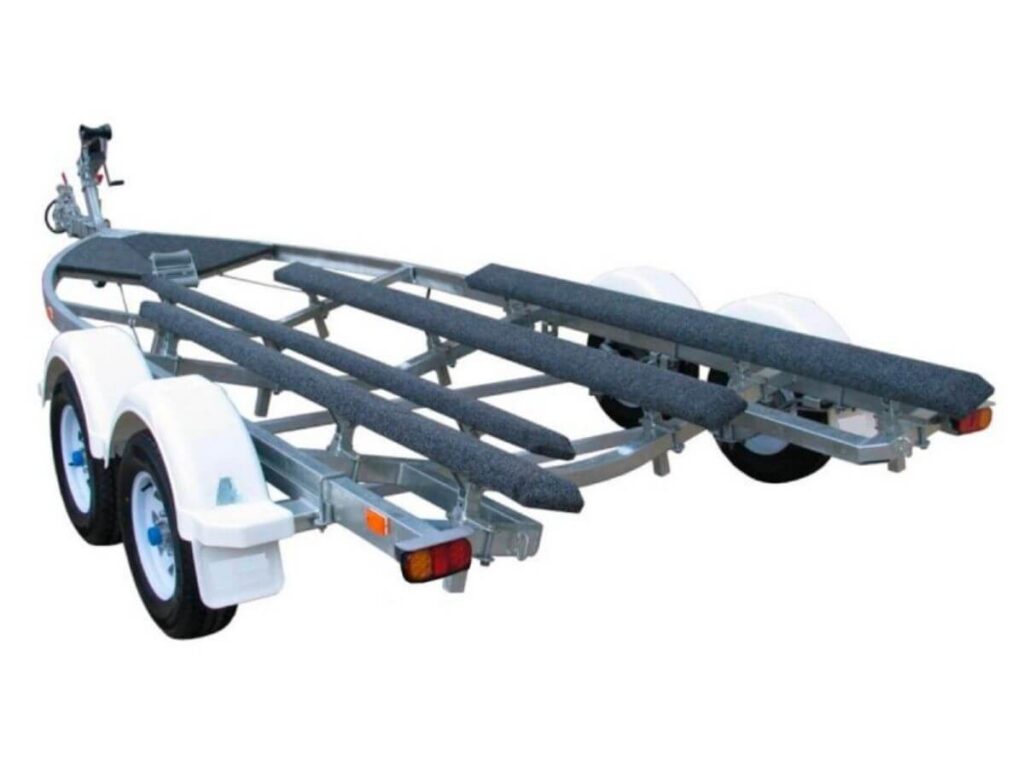
2. Roller Trailers
Roller trailers are designed for speed, convenience, and adaptability. Instead of bunks, they use multiple rubber or polyurethane rollers to support and guide the boat’s hull during loading and unloading.
They shine in situations where time, tide, and terrain don’t always cooperate, and you need gear that works fast, no matter what the launch site throws at you.
I’ve personally seen these trailers save crews hours on multi-launch days. Watching a 24-foot workboat glide off in seconds? It’s a beautiful thing when you’ve got deadlines breathing down your neck.
Best For
- Frequent loading/unloading in varied launch conditions
- Shallow or unpredictable water ramps
- Teams that manage multiple boat types or hull shapes
- Operations where time efficiency is non-negotiable
If your job site changes daily or your crews are constantly in and out of the water, roller trailers give you the flexibility you need.
Key Features
- Multiple rollers that pivot and adjust to different hull shapes
- Quick, low-effort loading and launching, even solo
- Typically made from galvanized or aluminum frames to withstand corrosion
- Compatible with both V-hull and modified hull boats
These trailers do a lot of the heavy lifting, literally and figuratively, so your crew doesn’t have to.
Considerations
- Higher upfront cost compared to bunk trailers
- More moving parts = more maintenance over time
- Requires careful adjustment and alignment to avoid hull damage
- Not always ideal for long-term storage, rollers don’t distribute weight evenly like bunks
Strengths and Weaknesses
- Strengths
- Extremely easy to launch and retrieve, even on shallow ramps
- Ideal for diverse fleets and varied hull designs
- Saves time on every launch—can make a real impact across a busy season
- Less strain on your crew = fewer accidents, faster turnaround
- Weaknesses
- More maintenance-intensive—you’ll need to stay on top of roller condition and alignment
- Can wear hulls faster if improperly adjusted or used roughly
- Less stable during transport compared to full-support bunk trailers
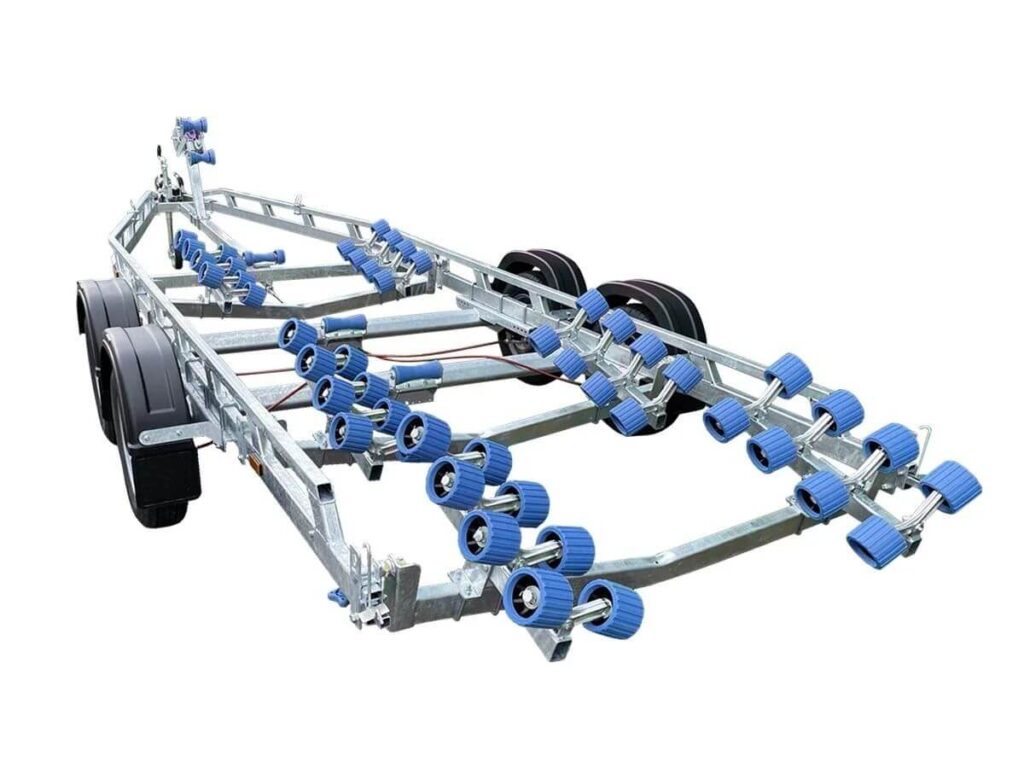
3. Float-On Trailers
Float-on trailers do exactly what the name promises: your boat floats on, and floats off. Instead of winching or cranking, you let the water do the work. These trailers are built for ease, especially when you’re launching larger or heavier boats from deep-water ramps.
At Rhinotrail, we’ve engineered float-on trailers with the realities of industrial and commercial use in mind. We know what it’s like when crews are battling tight schedules or long hauls, and we’ve built our trailers to handle all of it with less friction and a whole lot more confidence.
Best For
- Deep-water launches near marinas, ports, or large bodies of water
- Heavy boats that are hard to winch manually
- Operators prioritizing safety and ease of use, especially with large crews
- Companies with repetitive, high-volume marine workflows
If your team needs a consistent, reliable trailer that can move big vessels smoothly, this is your category.
Key Features
- Low-profile trailer design allows the boat to float on/off with minimal effort
- Supports heavier vessels, ideal for service boats, barges, and larger equipment
- Our Rhinotrail builds use reinforced frames, marine-grade hardware, and fully submersible lighting
- Typically paired with tandem or triple axles to support greater weight loads
We designed our float-ons to be user-friendly, especially in fast-paced, high-use environments.
Considerations
- Requires deeper launch ramps, won’t perform well in shallow or sloped entries
- Submersion means more exposure, axles and brakes need regular rinse-downs and inspection
- Not as fast as roller trailers in rapid back-to-back launches
- Not suited for rocky, uneven, or poorly maintained launch areas
Strengths and Weaknesses
- Strengths
- Effortless launch and retrieval, especially for large or commercial boats
- Less physical strain on your crew
- Designed for safety-first operations, especially with large vessels
- Highly durable builds when made by proven manufacturers like Rhinotrail
I’ve seen a 30-foot workboat float off one of our trailers with two crew members and no sweat. That’s peace of mind you can’t buy in a hurry.
- Weaknesses
- Limited by launch ramp depth, not ideal for remote or shallow water sites
- Higher maintenance needs if used in salt or brackish water
- Larger footprint requires more room for maneuvering and submersion
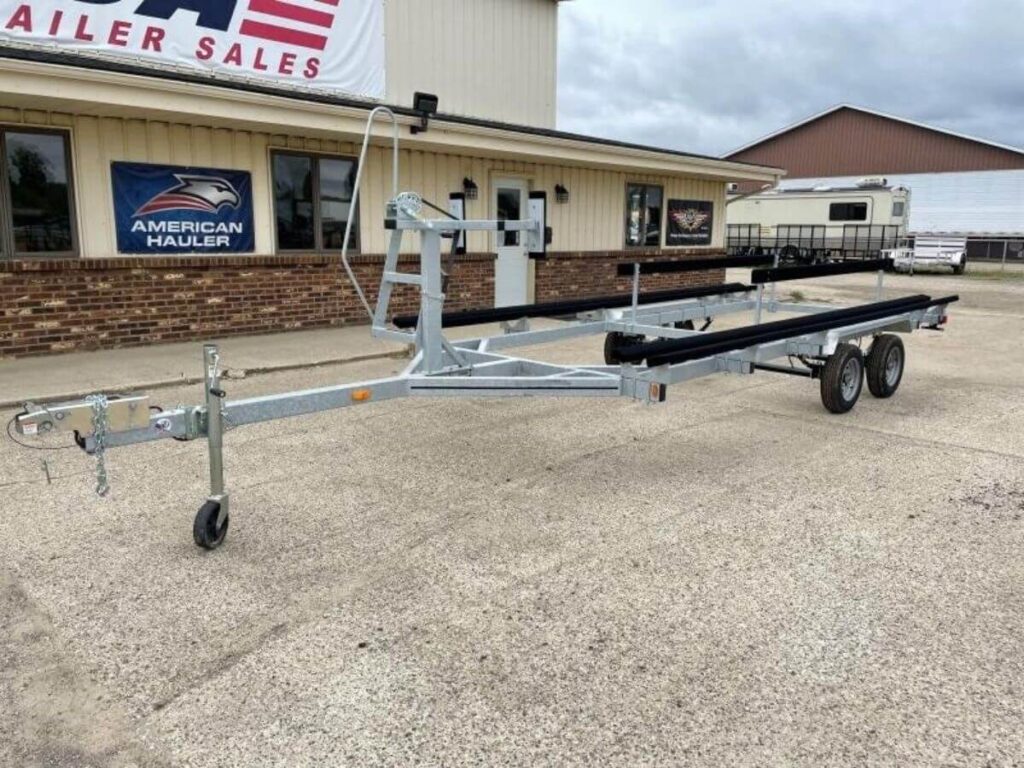
4. Keel Rollers with Side Bunks
Keel roller trailers with side bunks offer the best of both worlds, the guiding power of rollers down the center and the stable support of bunks along the sides. This hybrid setup is made for teams who don’t want to compromise between ease of loading and hull protection.
At Rhinotrail, we often recommend this configuration to businesses that operate in mixed environments. If you’re running heavy boats across shallow and deep ramps, or switching between launch points, this trailer gives you a lot of flexibility without giving up control.
I’ve worked with logistics teams who needed one trailer that could do it all. This setup? It checked every box.
Best For
- Medium to large boats requiring full-length support
- Mixed-use ramps (shallow and deep water access)
- Crews need guidance during loading, but also hull security during transit
- Companies transporting boats over long distances
If you’re stuck choosing between a bunk or roller setup, this combo is worth a serious look.
Key Features
- Keel rollers help center and guide the boat during loading
- Side bunks provide balance and full-length hull protection
- Reduces the risk of hull misalignment or bounce during transit
- Ideal for boats with V-hulls or deep hulls needing solid keel support
With this design, you’re not just making the job easier, you’re making it safer.
Considerations
- Slightly more complex setup than standard bunk or roller trailers
- Requires proper initial adjustment to match hull shape
- May cost more than a single-style trailer, but pays off in versatility
- Heavier build, you’ll want a properly rated tow vehicle for safe hauling
Think of this as the Swiss Army knife of boat trailers—built to adapt, not just sit idle.
Strengths and Weaknesses
- Strengths
- Smooth, guided loading with excellent hull alignment
- Superior support for long hauls and rough road conditions
- Perfect for crews who rotate boats or operate across various launch conditions
- Helps reduce boat damage, both on the road and on the ramp
I had one mining client running aluminum utility boats; they swapped to this setup and cut launch mishaps in half. No more mid-ramp realignments or hull scuffs.
- Weaknesses
- Setup takes time, you’ll need to get those rollers and bunks dialed in
- More moving parts = a bit more maintenance than basic bunks
- Not the cheapest option, but versatility often makes up for it
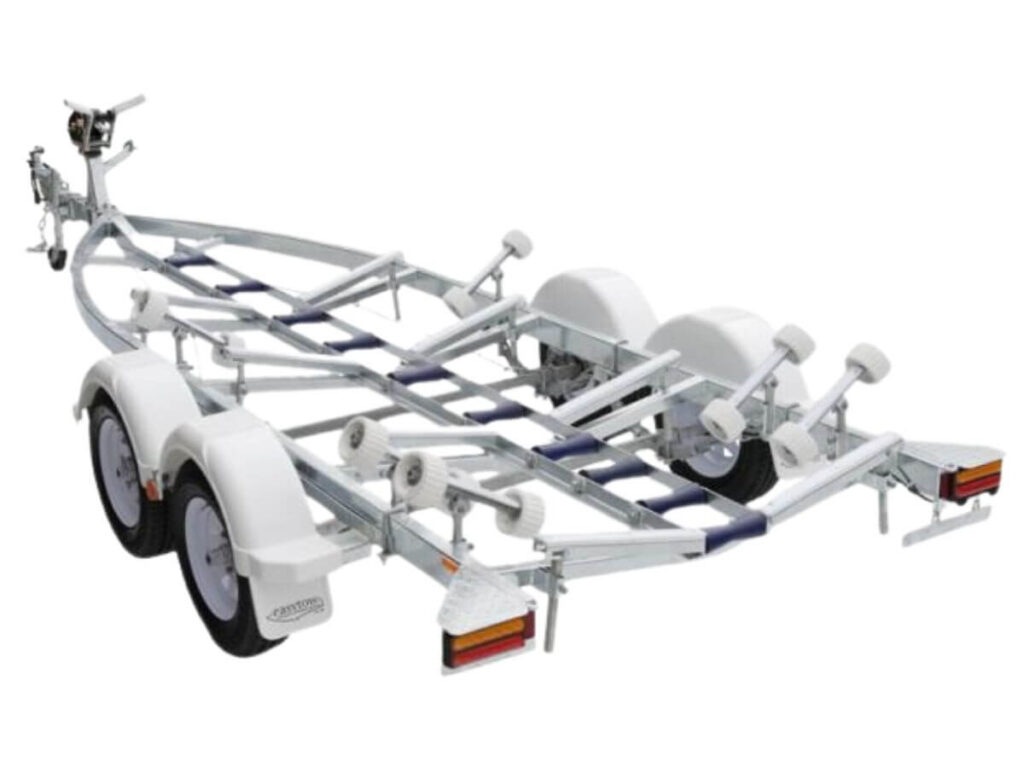
5. Pontoon Trailers
Pontoon trailers are purpose-built to haul one thing, and one thing only pontoons. Whether it’s a dual- or tri-toon boat, these trailers are designed with wide-set bunks or cradles to match the flat deck and tube-style hull of pontoon vessels.
Unlike standard boat trailers, pontoon trailers don’t guess. They’re engineered for stability, balance, and easy loading, even with the awkward shape and weight distribution that pontoons bring to the table.
I’ve seen operations try to modify standard trailers for pontoons. It never ends well. Bent frames, hull damage, unsafe loads. The right trailer makes all the difference.
Best For
- Pontoons used in commercial or field operations
- Floating work platforms or utility pontoons in agriculture, marine construction, or mining
- Wide-body vessels that require extra spacing and balance
- Companies transporting pontoons over uneven terrain or long distances
Key Features
- Wider frame with support bunks or pads specifically for pontoon tubes
- Optional guide posts or loading rails to help center the boat
- Available in scissor-lift or bunk-style configurations
- Often fitted with dual or triple axles to support large platforms
These aren’t general-purpose trailers; they’re custom-fit for stability and reduced risk.
Considerations
- Only designed for pontoon-style boats not usable for V-hulls or catamarans
- Loading height varies scissor-lift trailers sit lower, bunk trailers ride higher
- Be sure to match the trailer spacing and length to your pontoon specs
- May require wider turns and more caution when towing due to trailer width
Strengths and Weaknesses
- Strengths
- Tailor-made for pontoons, offers unmatched balance and safety
- Easy to load/unload with the right trailer-ramp pairing
- Reduces wear on tubes and minimizes stress points
- Great for field deployment, especially in agri or water-based industries
I’ve seen these used for floating irrigation rigs and mobile survey units. When the trailer fits right, it all runs smoother.
- Weaknesses
- Not versatile, you’re locked into pontoon use only
- Bulky on the road, you’ll need experienced drivers and solid route planning
- Slightly higher cost, especially with triple-toon or lift models
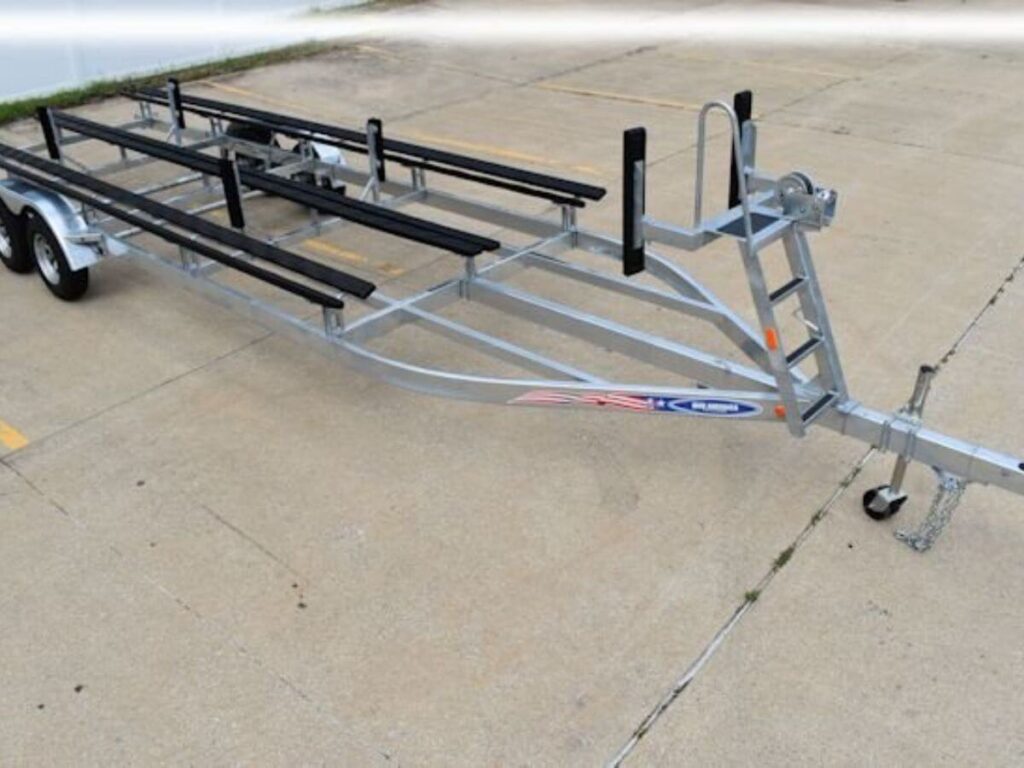
6. Catamaran Trailers
Catamaran trailers are engineered to do what standard trailers simply can’t, safely transport twin-hulled vessels. With wide spacing, high-clearance frames, and custom-adjustable supports, these trailers handle the unique demands of catamarans with ease.
Transporting a catamaran isn’t just about load capacity, it’s about geometry. These trailers account for the vessel’s width, balance, and low draft. And if you’ve ever tried to get a catamaran onto a regular trailer, you already know: that’s a headache waiting to happen.
Best For
- Dual-hull catamarans used in commercial, survey, or marine service
- Wider boats that don’t fit traditional V-hull trailers
- Industrial fleets operating in ports, offshore zones, or inland waterways
- Operations that need secure, stable trailering across longer distances
If your business relies on wide-bodied catamarans, this trailer isn’t optional, it’s essential.
Key Features
- Wide-frame design accommodates twin-hull spacing
- Adjustable bunks or cradles to match hull shape and size
- Built with higher ground clearance for hauling in rugged or uneven areas
- Typically supports custom fabrication to meet specific vessel dimensions
Some trailers come with winch systems or floating cradle setups, ideal for remote site operations.
Considerations
- Usually requires a custom fit, off-the-shelf models are rare
- More expensive upfront, especially with added axle or braking configurations
- Towing width can exceed standard limits, which may require permits for highway travel
- More complex loading process, often needing a trained crew or dock access
These trailers demand planning, but when safety and performance are on the line, they deliver.
Strengths and Weaknesses
- Strengths
- Perfectly matched for catamaran hulls, prevents stress fractures and misalignment
- Increased stability on the road due to even weight distribution
- Can be customized for commercial-grade durability
- A true fit for survey boats, offshore transport, or multi-hull utility vessels
- Weaknesses
- Limited flexibility, not usable for monohulls or pontoons
- Higher investment and lead time for custom specs
- Requires wide-load awareness, not every route or team is equipped for it
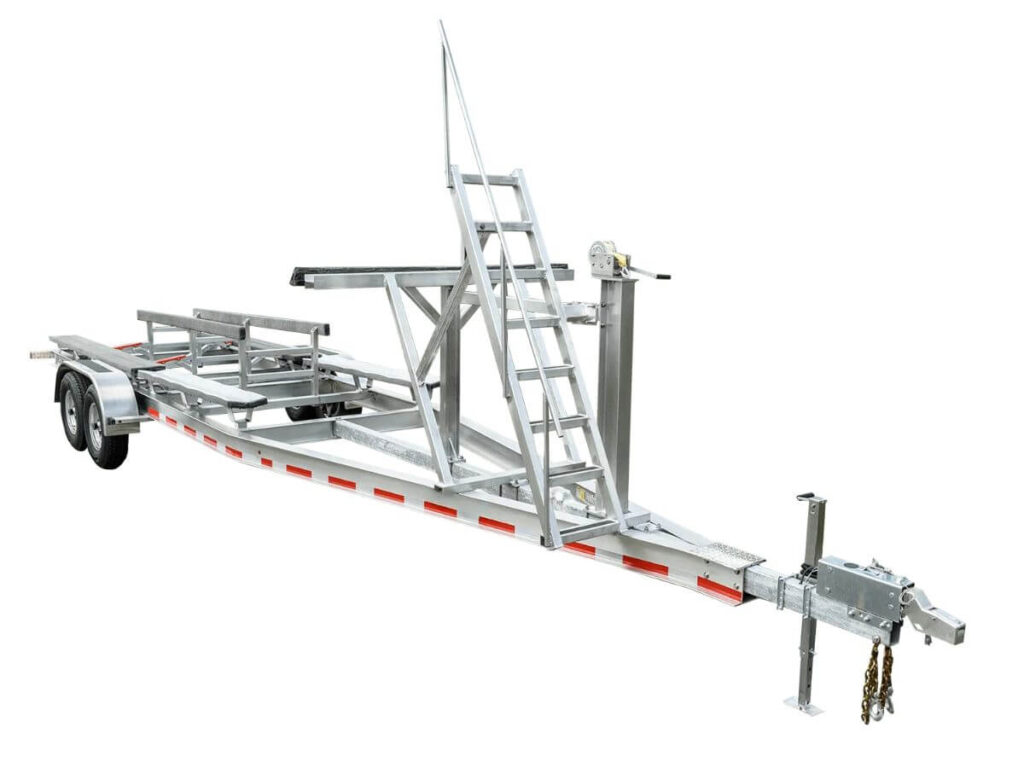
7. Custom/Industrial Trailers
When standard trailers just don’t cut it, custom or industrial-grade boat trailers step in. These trailers are engineered from the ground up to meet the specific demands of heavy-duty operations.
You don’t buy one of these trailers off a shelf. You build it to match your workload, your environment, and your fleet.
I’ve seen these used to transport massive barges through oil fields or support military-grade equipment for marine operations. When everything is riding in one haul, this is the trailer you trust.
Best For
- Oversized, unusually shaped, or extra-heavy vessels
- Industrial operations in oil & gas, mining, energy, and large-scale construction
- Environments that require extreme durability, gravel, saltwater, mud, and more
- Companies needing custom builds to fit specific specs or compliance standards
If you’re hauling something no one else wants to touch, this is your tool.
Key Features
- Custom-fabricated frames tailored to vessel dimensions and weight
- Heavy-duty materials like reinforced steel, high-capacity axles, and industrial-grade brakes
- Multiple axle options (tandem, triple, quad) for safe load distribution
- Often includes winch towers, lighting systems, hydraulic assist, or air ride suspensions
- Designed with compliance in mind, DOT specs, over-width permits, safety protocols
Considerations
- Higher upfront cost and longer lead time, you’re building it right, not fast
- Requires detailed planning: specs, usage case, environment, transport routes
- Maintenance needs vary depending on design and terrain
- Often needs special permits for road use due to size and weight
Strengths and Weaknesses
- Strengths
- Completely tailored to your vessel, fleet, and job site
- Built to handle abuse, gravel, off-road, steep ramps, heavy loads
- Can integrate with fleet logistics systems, GPS, or load-monitoring tech
- Delivers peace of mind when your cargo can’t afford to fail
I’ve worked with clients in remote energy fields where every single mile matters. These trailers showed up, took a beating, and never blinked.
- Weaknesses
- Costly and time-consuming, not for low-volume or light-use operations
- Not interchangeable, you build it for one use case, not flexibility
- You’ll need a strong vendor relationship and clear specs to avoid delays or mismatches
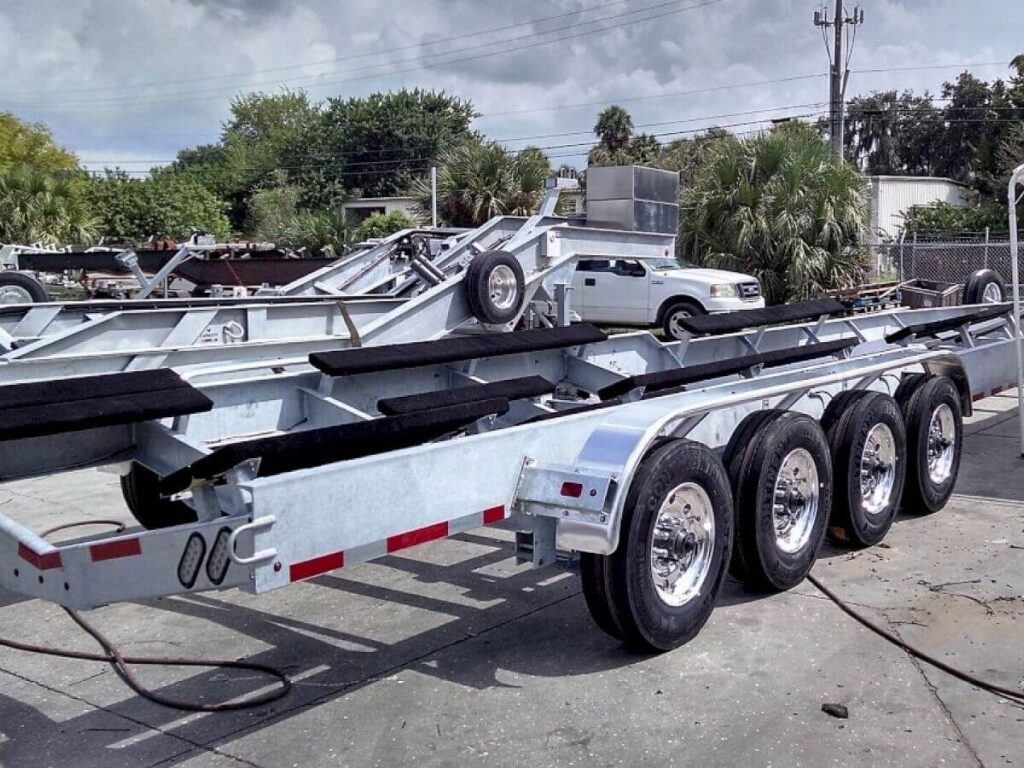
8. Tilt Trailers
Tilt trailers are all about simplicity and grit. Instead of relying on ramps, winches, or deep water, these trailers use a pivoting bed that tilts to let the boat slide off or roll back on. It’s a smart, mechanical solution for remote job sites, rough terrain, or shallow, uneven launch conditions.
If your team is constantly fighting with poor launch access or you’re hauling in areas where standard trailers can’t perform, a tilt trailer can feel like a game-changer.
I remember helping a field crew working on a riverbank launch in a mining zone, no dock, no ramp, just dirt and nerves. A tilt trailer was the only reason we got that vessel in the water safely.
Best For
- Shallow water or no-ramp environments
- Remote job sites with limited infrastructure
- Utility boats, small workboats, or survey vessels used in rugged conditions
- Teams that value manual control and simple mechanisms over complex systems
Key Features
- Hinged or hydraulic tilting bed allows gravity-assisted loading/unloading
- Available in full-tilt or partial-tilt configurations
- Often built with low-profile frames for easier handling in rough terrain
- Compatible with smaller to mid-sized vessels
You get a lot of control with these, no deep ramps, no winch strain, no wasted time.
Considerations
- Not ideal for large or heavy boats—better for moderate loads
- Learning curve—requires trained operators to manage tilt safely
- Less secure for transport if not properly balanced or locked down
- Fewer customization options compared to industrial or multi-axle builds
Strengths and Weaknesses
- Strengths
- Works where ramps don’t, great for field use, agriculture, or survey crews
- Minimal setup required, fast deployment, especially in time-sensitive jobs
- Low maintenance, fewer components to break or fail
- Allows solo or small-crew launching with less physical strain
- Weaknesses
- Limited to smaller boats, not designed for heavy-duty industrial loads
- Less stable during transport unless carefully loaded and secured
- Manual tilt systems can wear out if overloaded or poorly maintained
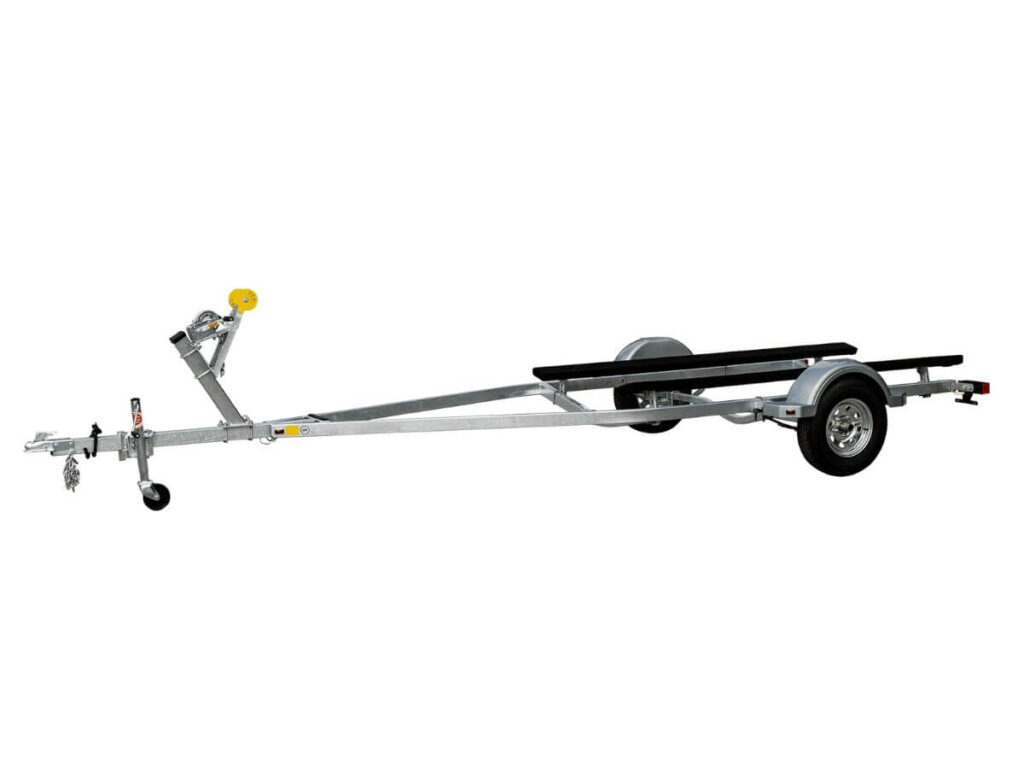
Conclusion
You came here to find the right boat trailer and now, you know the 8 types that truly matter.
From bunk simplicity to industrial muscle, we’ve seen these trailers work in the harshest job sites. I’ve stood on gravel banks, watched crews struggle, and then succeed with the right trailer under them.
Your next step? Choose a trailer that won’t hold you back.
What’s stopping you from making a smarter investment today?
Contact us today we’ve worked with teams just like yours, and we’re ready to help.


